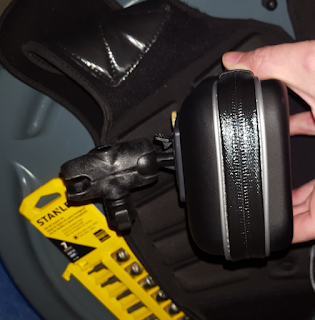Mr. Wilkins was an associate manager in a large grocery chain store. His purview was fruits and vegetables. Not content with this section, he had aspirations one day to be an assistant manager, maybe, dare he think it, a manager. His domain could be produce of all kinds, frozen foods, maybe even Pharmacy. He had dreams. But for now, it was all apples and oranges.
Oh yes, oranges. In the back room sat several automated devices that did tedious tasks. One was an orange-stamping machine. Its purpose was to put produce number stamps on the oranges. It ran itself, all day long, stamping oranges. The labels needed re-filling once a day, but that was it. It hummed along stamping oranges at the rate of one per second. The rate was reported by the machine on an LED panel.
Every day, Wilkins peeked in on the machine to see how it was doing. Sometimes at noon, at times at 2:00, but daily. Every day it was found to be running just fine.
Then one day Wilkins asked himself how he could get noticed. After all, an assistant manager job in another store was opening up soon. He wanted to know that he had a chance at it. The district manager was due to visit in a week and he just knew he'd be overlooked if he didn't have something positive to report. So he dared to dream.
He walked up to the orange-stamping machine and began fiddling with the controls. He wasn't entirely sure how it worked but no matter. He changed a few settings. After a minute or so of tinkering, the number on the LED panel changed to 1.2. The machine was now stamping oranges at the rate of 1.2 per second: a 20% increase.
The next day the machine continued to report the success. In fact it did so all week.
When the DM appeared, he walked through the store, led by the store's GM. When they came to fruits and vegetables, Wilkens was sure to be present. The GM introduced him to the DM. The DM asked, "So Wilkins, how are things in your area?"
"Fine, sir. Glad to report that due to modifications I made to the orange-stamper, we now get the oranges stamped at a 20% faster rate than at any time before."
"Great work, young man. Now tell me, can you make that 30 percent?"
"Thirty? Well sir, I can sure try!"
"That's the spirit, lad. Tell me how things are a week from now when I return."
And off they went.
The next day, Wilkins visited the orange-stamper again. He was excited. Maybe now was his Big Chance. He took to fiddling with the machine again. After about five minutes, the machine stopped stamping oranges.
Wilkins was flummoxed. It had been working fine before. He tried re-setting knobs. He tried re-setting handles. Nothing worked. Frustrated, he began whacking at it. A few parts fell off. That was bad.
Wilkins took the parts into a hardware store. The clerk said yes, he knew about these machines. And these days, new parts were available, better than those. For a price, they can be yours. Wilkins paid the price. He was desperate. Back he went to the store.
Unexpectedly, the DM was there. It was a surprise. He was visiting the GM about something else. And Wilkins was noticed upon re-entrance.
"Mr. Wilkins, good day young man. How is our orange-stamper doing today?"
Fate had conspired. He didn't want to lie. He knew too that he was a bad poker face. He decided to just do the "right thing". Maybe it would be good. It'd make him look courageous.
"Bad news, sir. The machine is... a bit broken."
"Broken? How?" The DM looked annoyed.
Wilkins' courage escaped him.
"Well you see sir... I was trying to get it to 30% like you said but then... it broke down." He paused. "Parts, sir. Parts fell off the machine."
"Well that IS a terrible timing! But you know, machines, they always give trouble. Do you have a way to fix it?"
"Yes sir. I have new parts right here!"
"Ahh, good. Well, get to it young man. I want to know status by tomorrow at 3:00. Call me at headquarters."
"Yes, sir!"
With that, Wilkins headed to the back room. And for three hours, he tried fitting the new parts into the machine. It was a challenge. Then he tried re-starting the machine. He then began fiddling again. The machine struggled. But in the end, it ran. Only, the LED read "0.8". The oranges were getting stamped now at 8/10ths of an orange per second, or one every 1.2 seconds. This was a step backwards. But at least the machine was working again.
Wilkins was now less sure of himself. He decided to content himself with 0.8 oranges per second, at least for now. He could at least report that the machine was working. But it cost money to replace the parts, and it didn't work as well this time.
The following day, Wilkins called the DM. He dreaded it but had this advantage: the DM had never even seen the machine. He didn't know if 0.8 was the improved rate or not. And if he never saw it at 1.0 or 1.2, why should he be concerned?
Wilkins reported good news: the machine was now working. Asked how well, he proudly reported "One orange every 1.2 seconds, sir!"
"Great news, my boy. Yes those confounded machines, always breaking down. They cost too much too. Too bad we can't get rid of them!"
"Ha ha ha... yes sir!"
Wilkins celebrated three weeks later his promotion to assistant manager. He was transferred to the new store.
The orange-stamper, meanwhile, stayed put. It continued to stamp oranges. It didn't move a whisker from where it was placed though its former overseer did. But it only stamped 1.2 oranges per second. And no one knew that previously, it had done so at a 40% higher rate. Not that it would have made much difference to the machine itself, for it was destined to stay in that back room no matter how fast it stamped oranges.
And so it goes.









